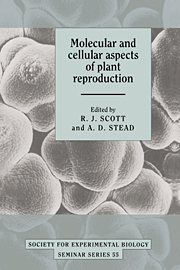Book contents
- Frontmatter
- Contents
- List of Contributors
- Introduction: ‘Where do we go from here?’
- Molecular control of floral organogenesis and plant reproduction in Petunia hybrida
- Control of floral morphogenesis in cauliflower (Brassica oleracea L. var. botrytis): the role of homeotic genes
- Isolation and properties of mutants of Arabidopsis thaliana with reduced sensitivity to short days
- Asexual mutants in Melandrium album (Silene alba): tools in cDNA cloning and analysis of an X/Y chromosome system in plants
- Pollen exine – the sporopollenin enigma and the physics of pattern
- The diversity and regulation of gene expression in the pathway of male gametophyte development
- Characterisation of Arabidopsis thaliana anther-specific gene which shares sequence similarity with β-1,3-glucanases
- Ovule cDNA clones of Petunia hybrida encoding proteins homologous to MAP and shaggy/zeste-white 3 protein kinases
- Towards the elucidation of the mechanisms of pollen tube inhibition during the self-incompatibility response in Papaver rhoeas
- Intracellular movement and pollen physiology: progress and prospects
- Organisation and functions of cell surface molecules on gametes of the brown algae Fucus
- Strategies of flower senescence – a review
- The physiology of petal senescence which is not initiated by ethylene
- Molecular biology of flower senescence in carnation
- Ethylene sensitivity and flower senescence
- Ethylene biosynthetic genes and inter-organ signalling during flower senescence
- Index
The diversity and regulation of gene expression in the pathway of male gametophyte development
Published online by Cambridge University Press: 04 August 2010
- Frontmatter
- Contents
- List of Contributors
- Introduction: ‘Where do we go from here?’
- Molecular control of floral organogenesis and plant reproduction in Petunia hybrida
- Control of floral morphogenesis in cauliflower (Brassica oleracea L. var. botrytis): the role of homeotic genes
- Isolation and properties of mutants of Arabidopsis thaliana with reduced sensitivity to short days
- Asexual mutants in Melandrium album (Silene alba): tools in cDNA cloning and analysis of an X/Y chromosome system in plants
- Pollen exine – the sporopollenin enigma and the physics of pattern
- The diversity and regulation of gene expression in the pathway of male gametophyte development
- Characterisation of Arabidopsis thaliana anther-specific gene which shares sequence similarity with β-1,3-glucanases
- Ovule cDNA clones of Petunia hybrida encoding proteins homologous to MAP and shaggy/zeste-white 3 protein kinases
- Towards the elucidation of the mechanisms of pollen tube inhibition during the self-incompatibility response in Papaver rhoeas
- Intracellular movement and pollen physiology: progress and prospects
- Organisation and functions of cell surface molecules on gametes of the brown algae Fucus
- Strategies of flower senescence – a review
- The physiology of petal senescence which is not initiated by ethylene
- Molecular biology of flower senescence in carnation
- Ethylene sensitivity and flower senescence
- Ethylene biosynthetic genes and inter-organ signalling during flower senescence
- Index
Summary
Summary
The highly specialised angiosperm male gametophyte is both the site of production and the vehicle by which the male gametes are transported to the embryo sac to participate in fertilisation. Because of its relative simplicity compared with the sporophyte and accessibility for cytological and molecular analysis, the male gametophyte represents an excellent system in which to unravel the molecular basis of gene regulation and cellular differentiation in plants. The intent of this chapter is to review evidence for haploid gene expression in the developing male gametophyte, emphasising in particular the contribution of molecular cloning and transgenic approaches. cDNA cloning and RNA analysis has led to the characterisation of more than 30 microspore or pollen-expressed genes from 12 different plant species which are preferentially activated at particular stages of development. Two broadly defined groups of pollen genes are recognised; the ‘early genes’, which are activated prior to pollen mitosis I (PMI), and the ‘late genes’ which are first activated after PMI. Promoter studies have demonstrated differential gene expression between the vegetative and generative cells and insight into the significance of PMI for late gene activation. Detailed analyses of the promoters of several late pollen genes have led to the identification of several distinct cis-regulatory elements which control both the level and specificity of haploid gene expression. Some of these regulatory elements are functionally conserved among homologous promoters from diverse plant species and among different promoters within a single species.
- Type
- Chapter
- Information
- Molecular and Cellular Aspects of Plant Reproduction , pp. 83 - 136Publisher: Cambridge University PressPrint publication year: 1994
- 30
- Cited by

